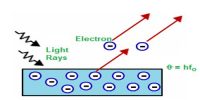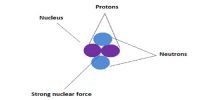Every point of a body immersed in a fluid will experience thrust in all directions. Let a cylinder PQRS is of cross-sectional area A and height h. It is submersed in a fluid of density ρ. The depth of the upper and lower surface of the cylinder from the free surface of the fluid are h1 and h2 respectively.
So, h = h2 — h1 The downward force acting on the surface PQ of the cylinder, F1 = Ah1 ρg
The upward thrust exerted by the liquid on the surface SR of the cylinder, F2 = Ah2 ρg
The lateral pressures experienced by the curved surface of the cylinder being equal and opposite of each other it become neutralized.
Upward thrust or magnitude of buoyancy:
F2 – F1
= Ah2 ρg – Ah1 ρg
= A (h2 – h1) ρg
= Ah ρg
= (hA) ρg
= V ρg (V = hA = volume of the cylinder)
= weight of the displaced fluid by the cylinder.
So, the upward thrust or buoyancy acting on a submersed body is equal to the weight of the fluid displaced by it. For this upward thrust it seems that a submersed body losses weight.












